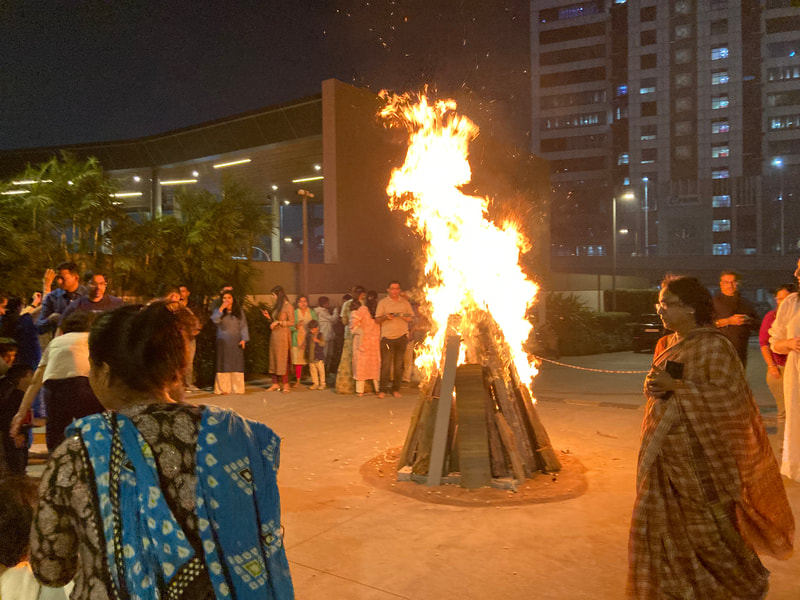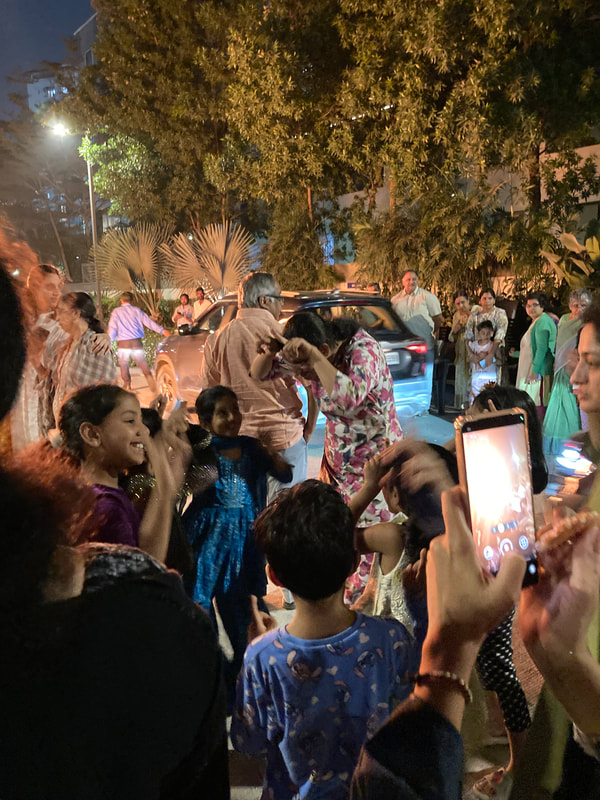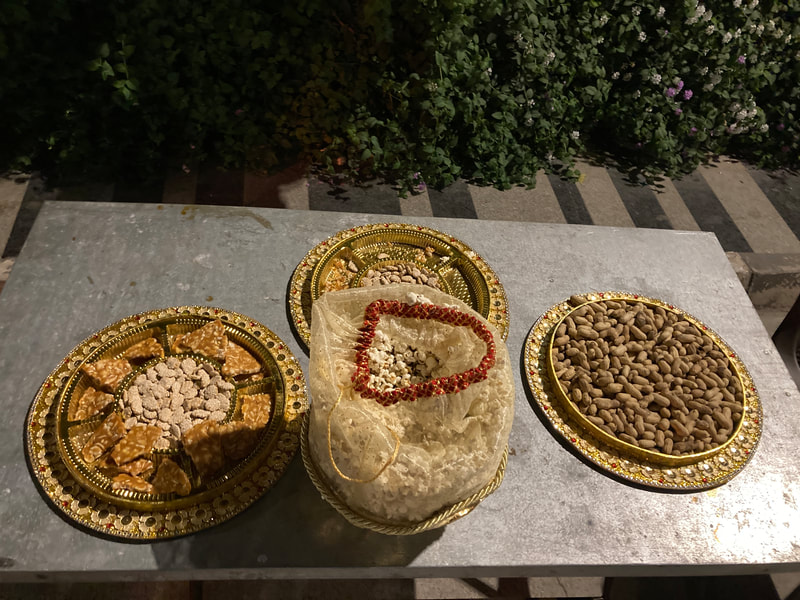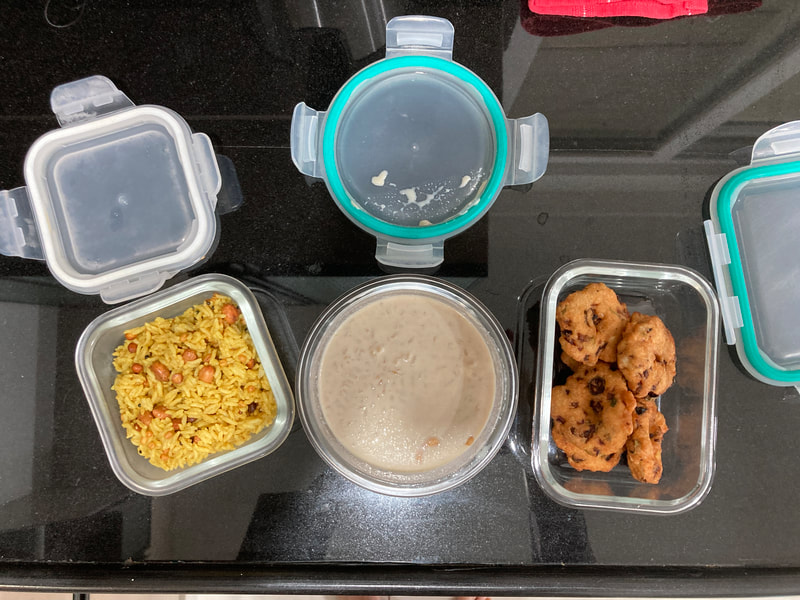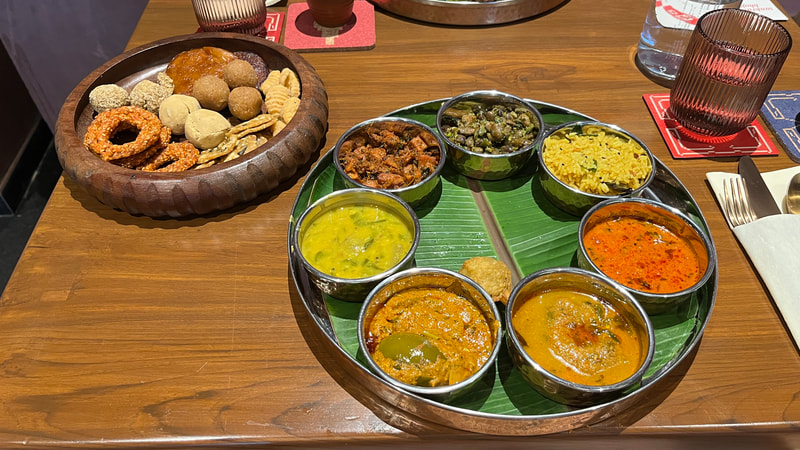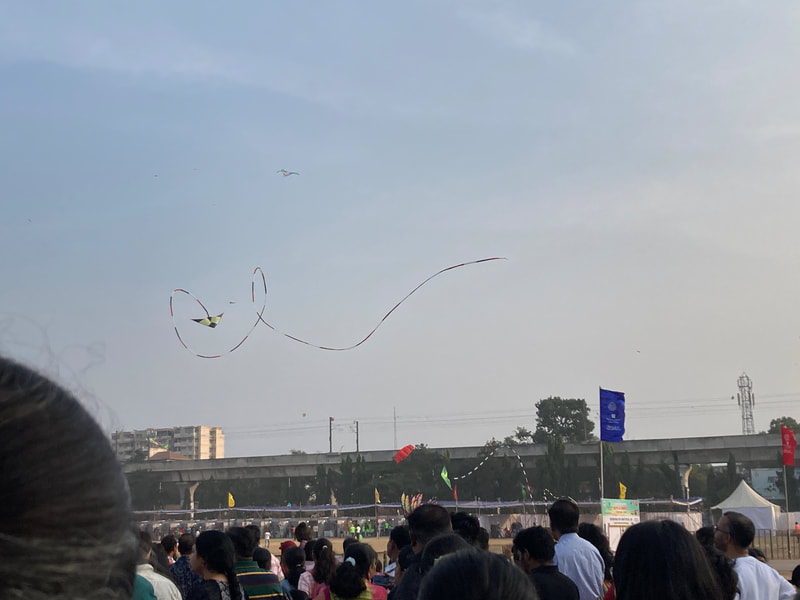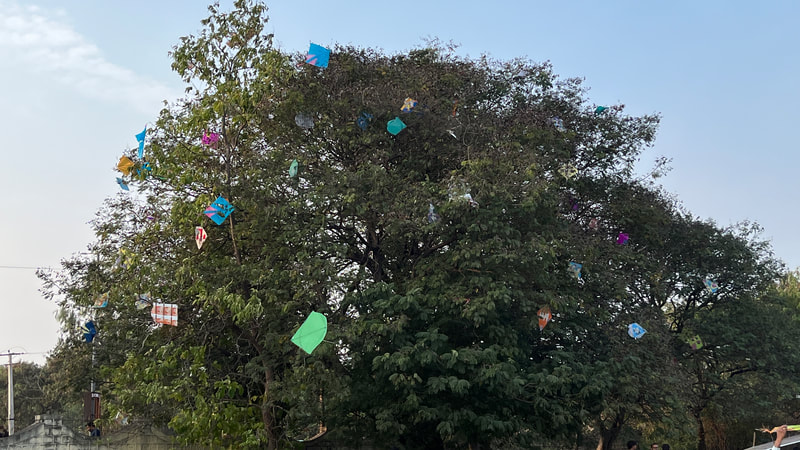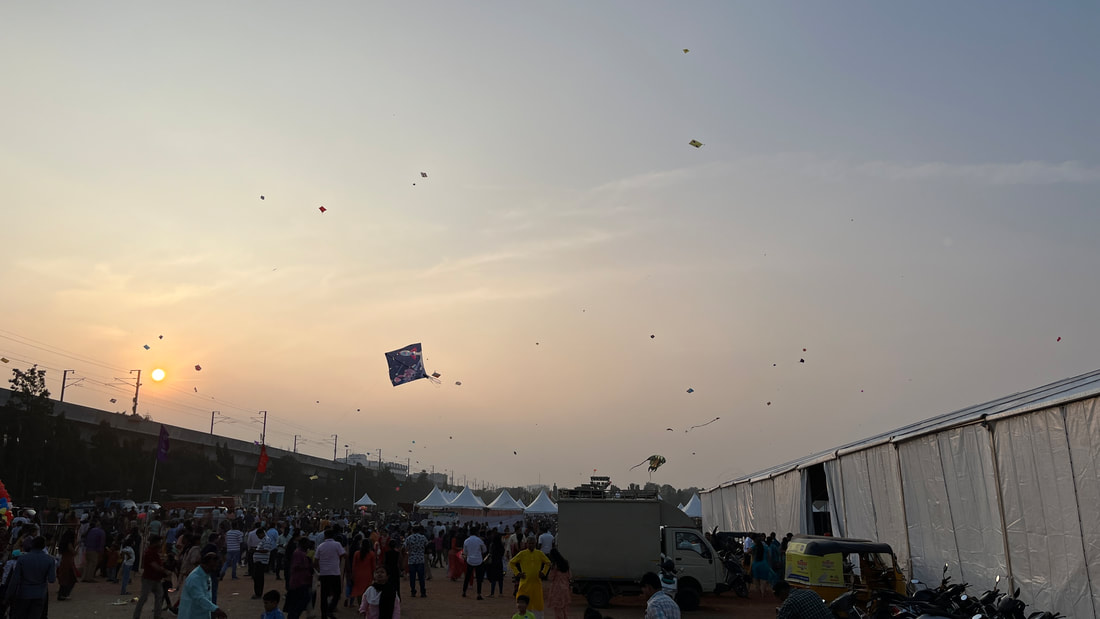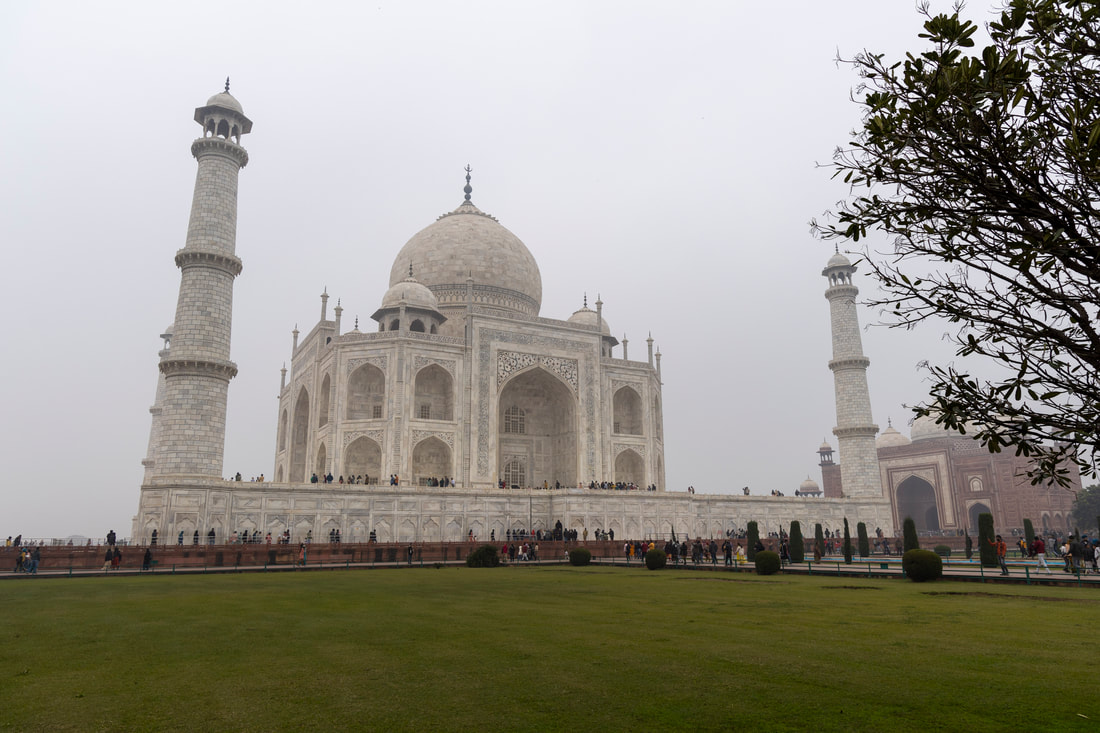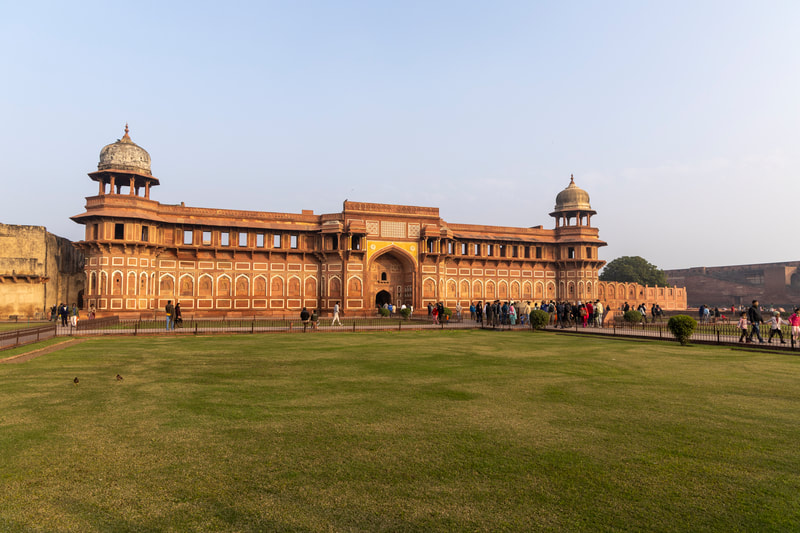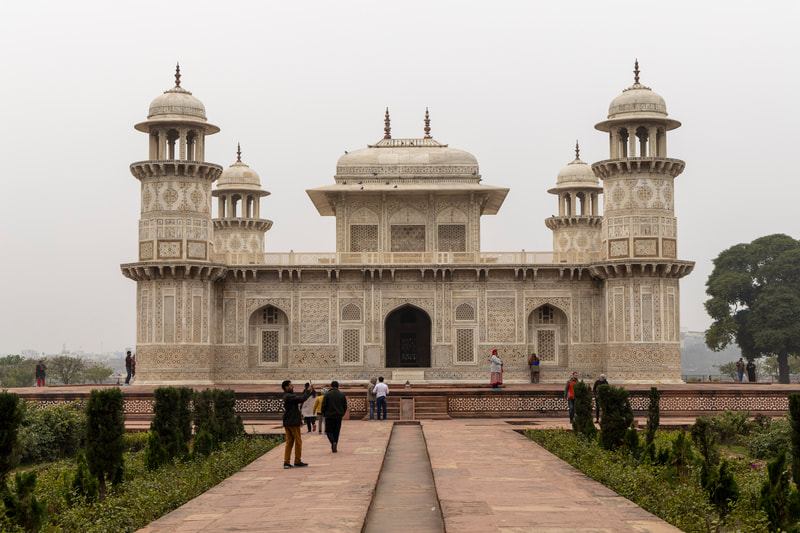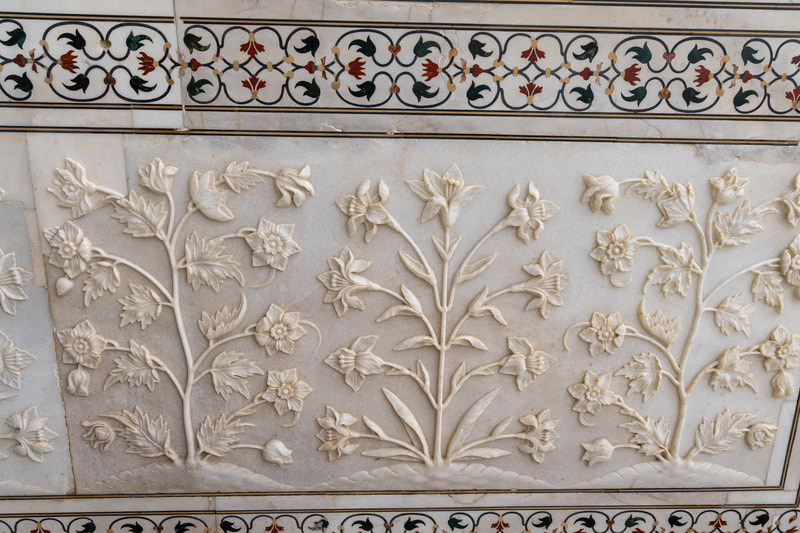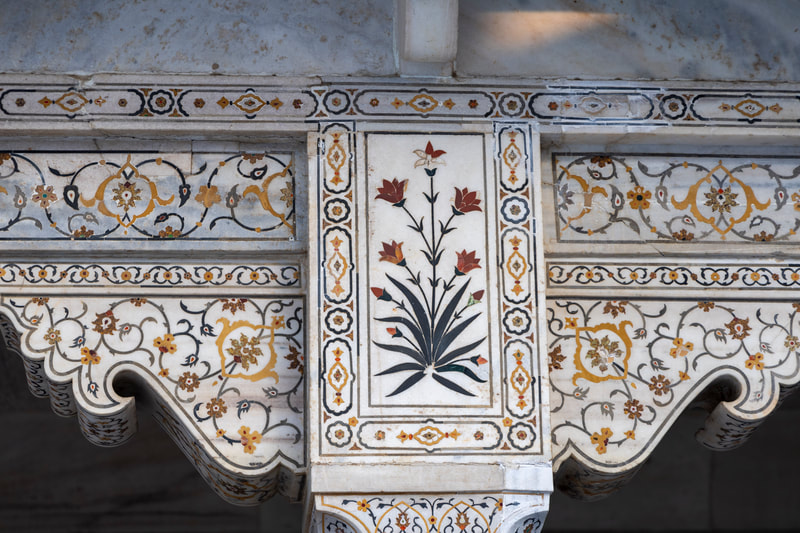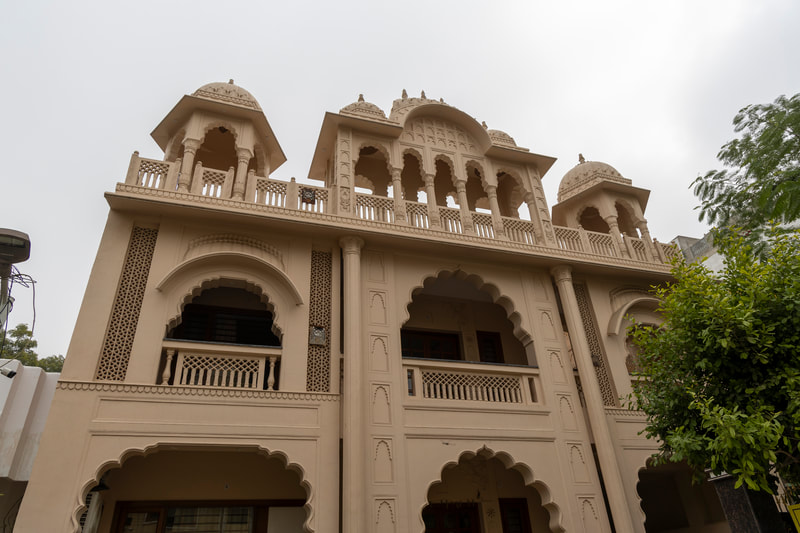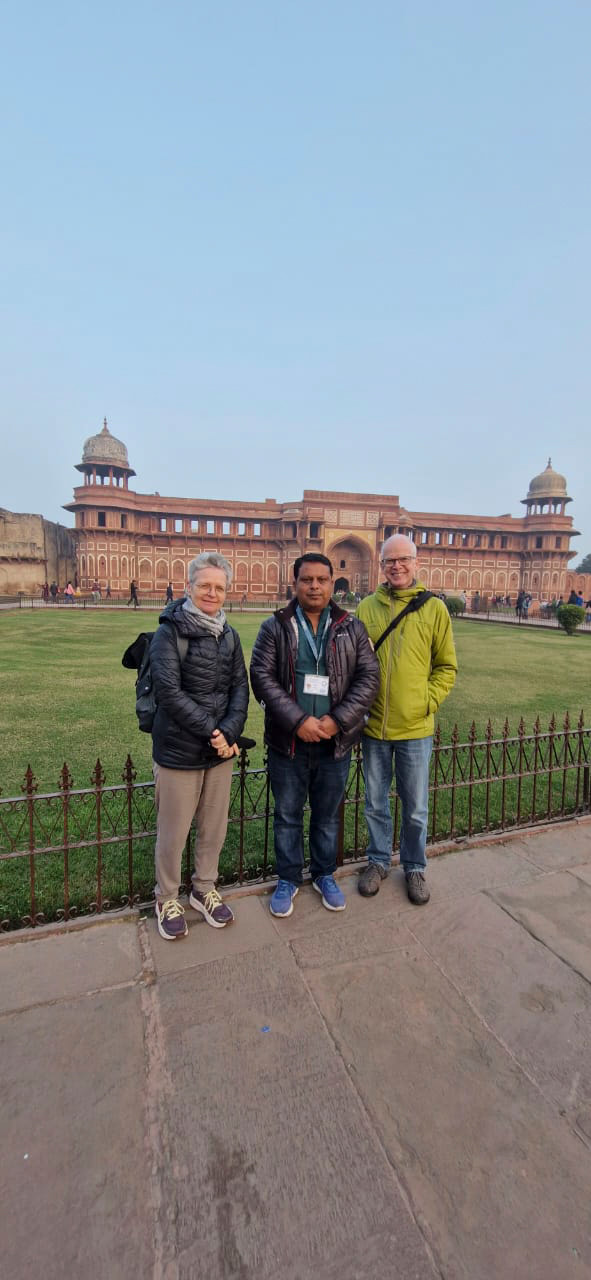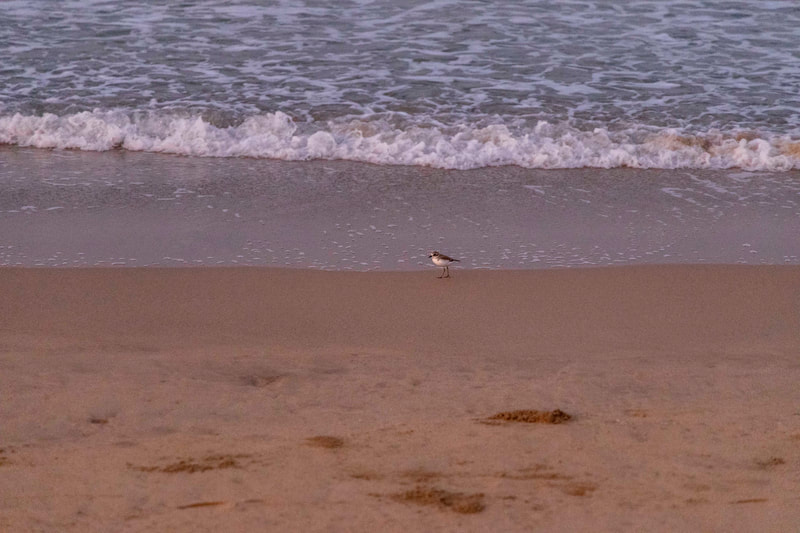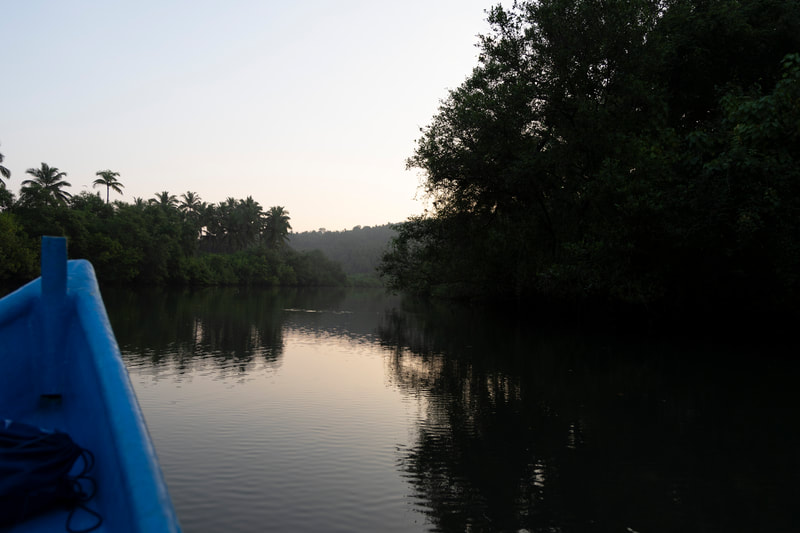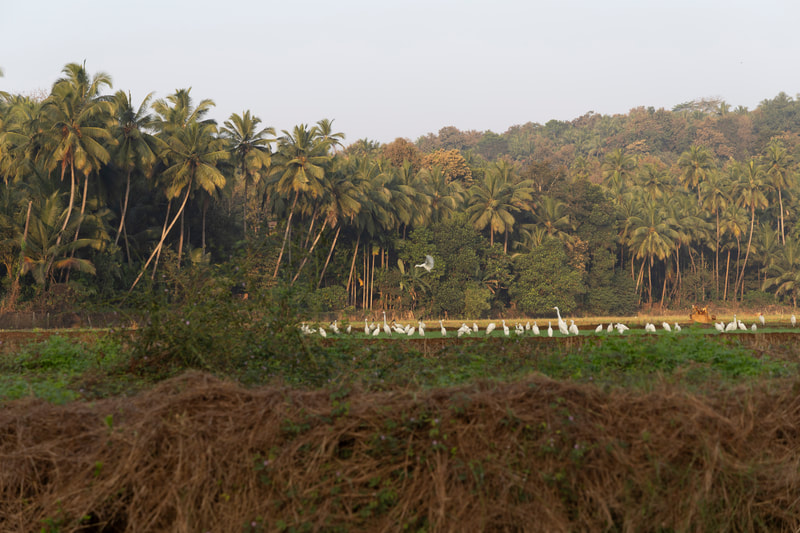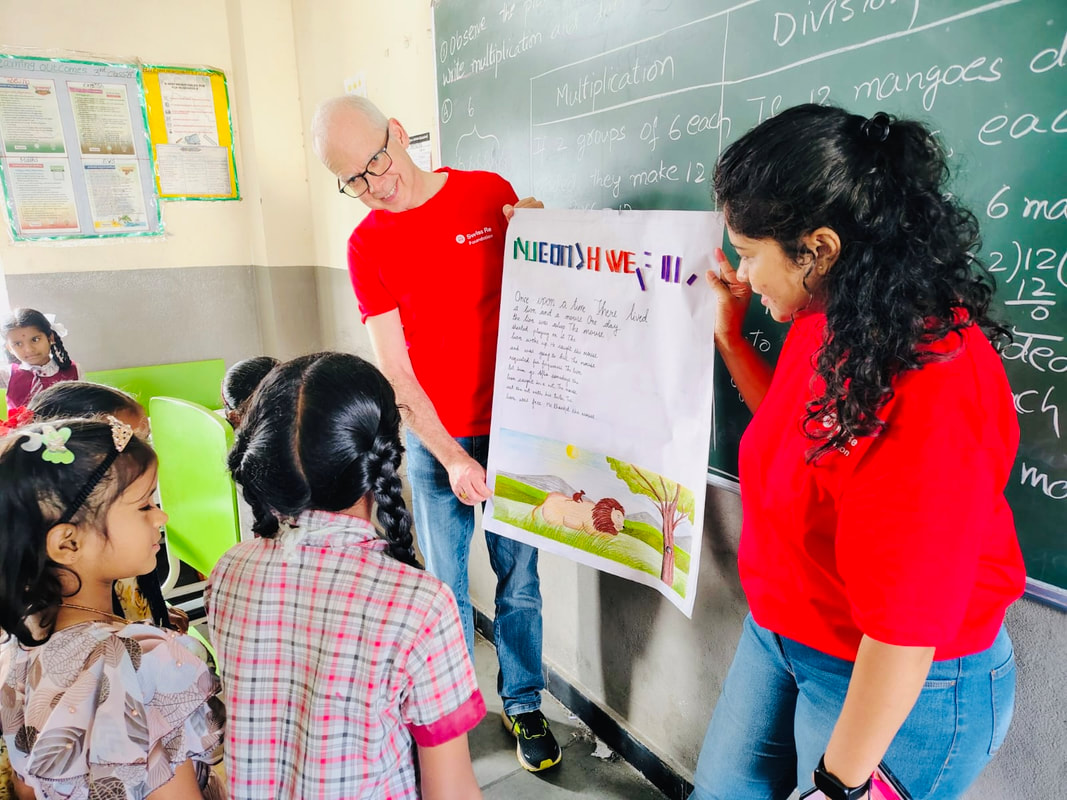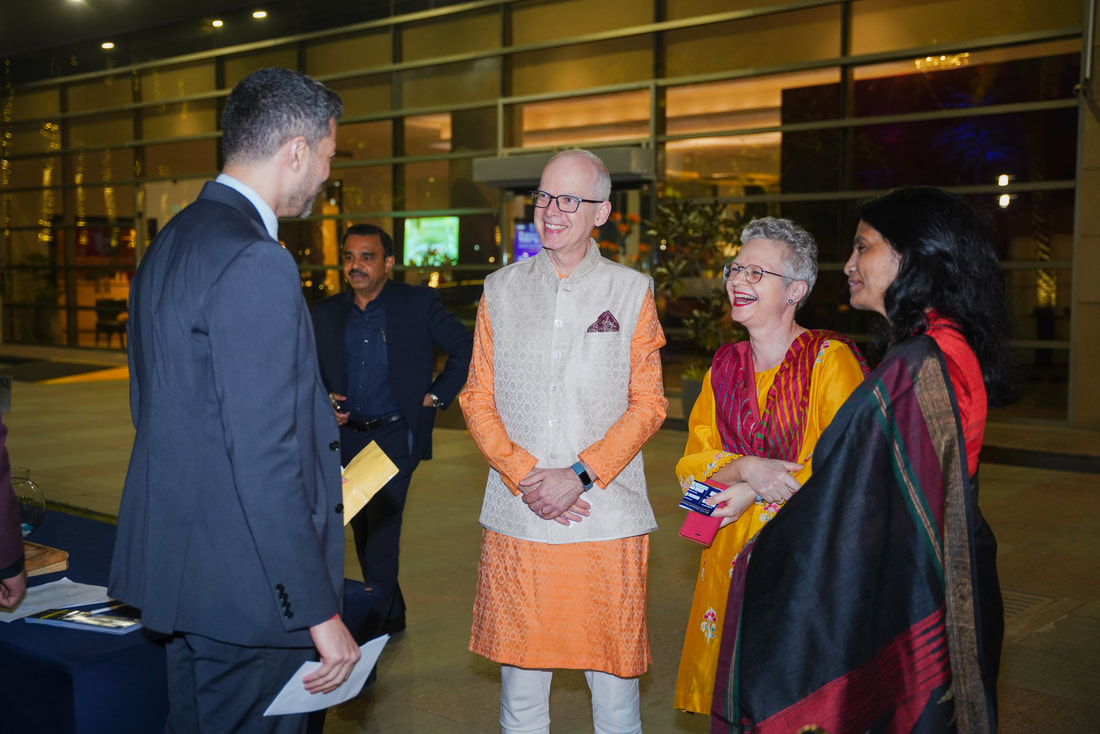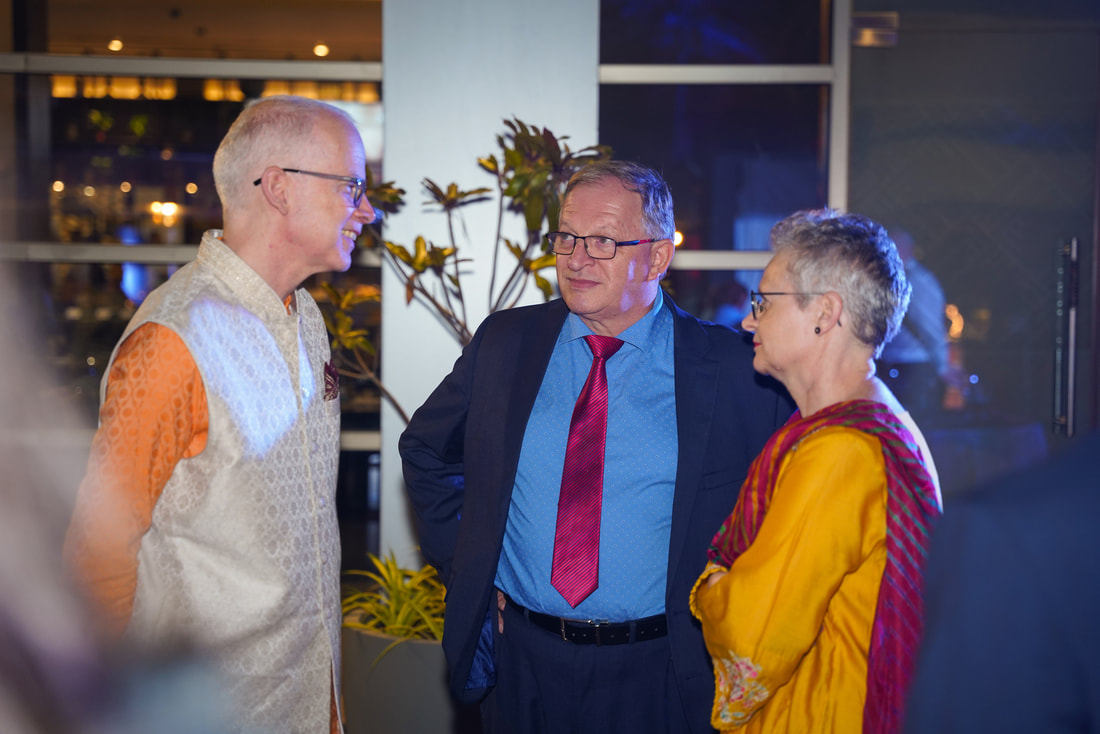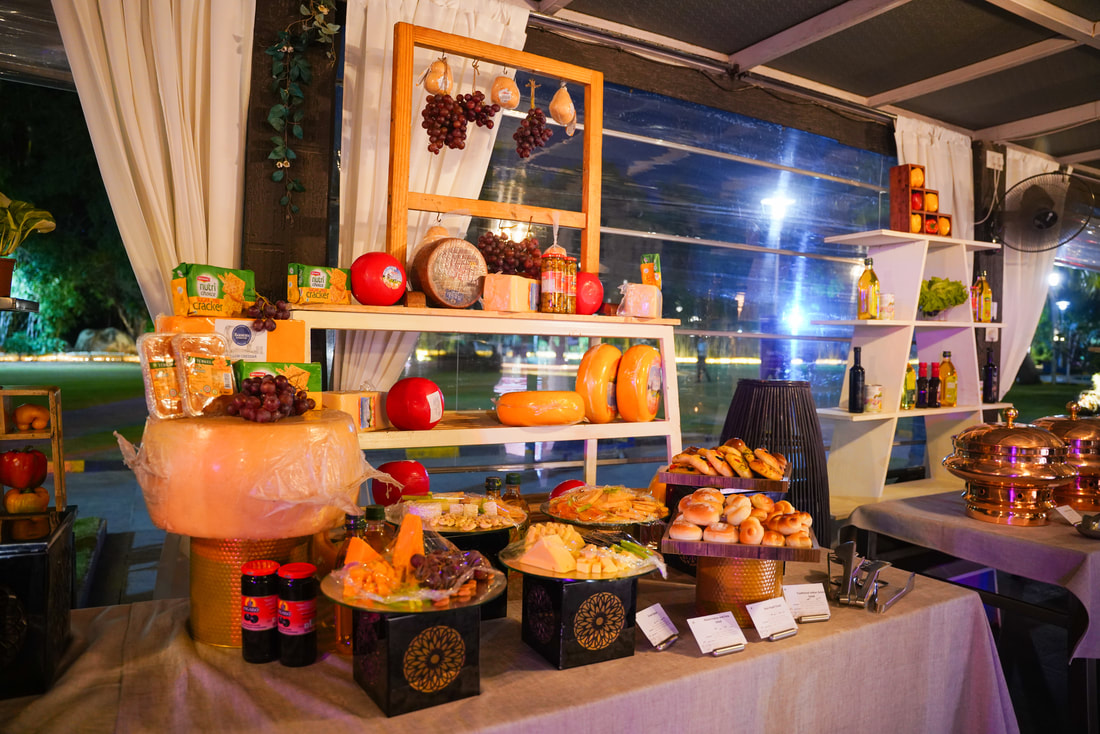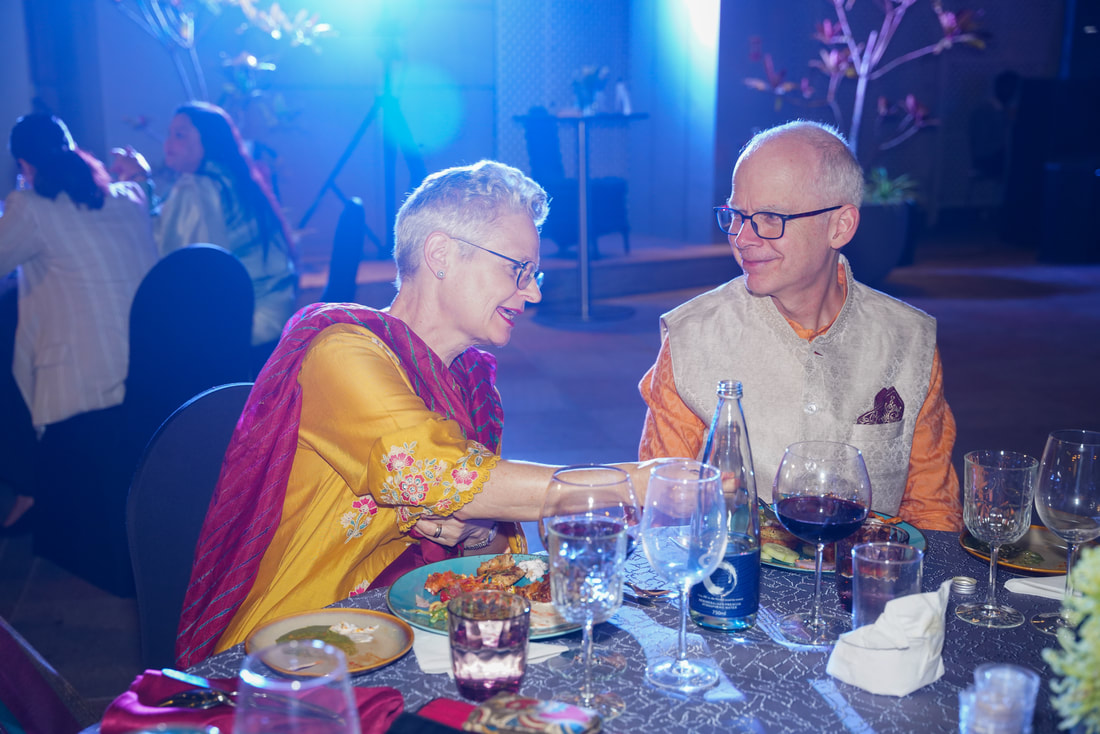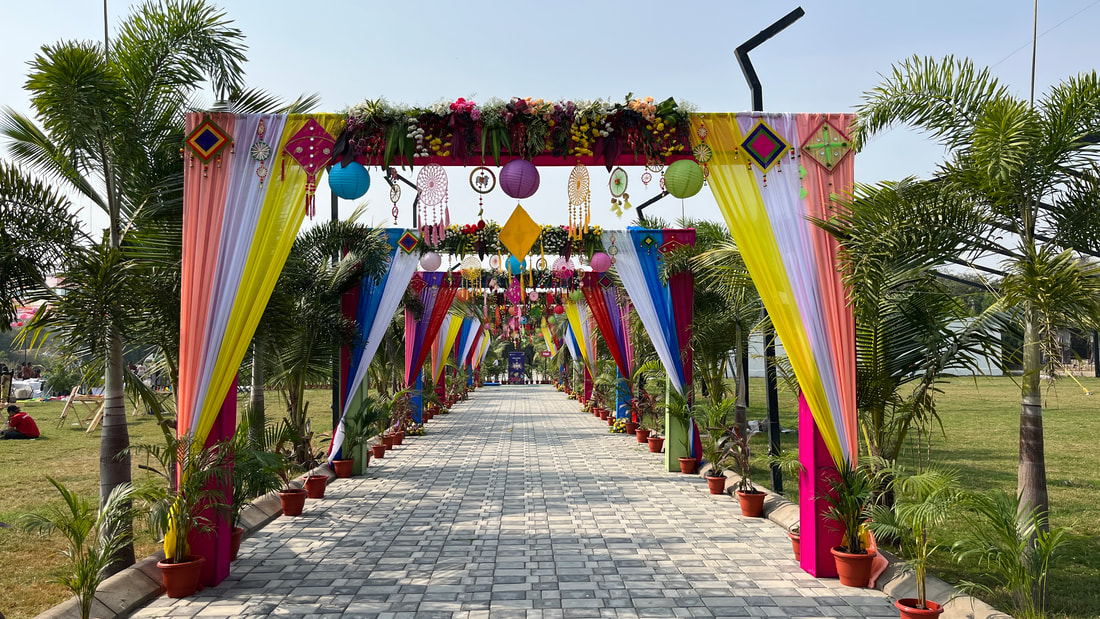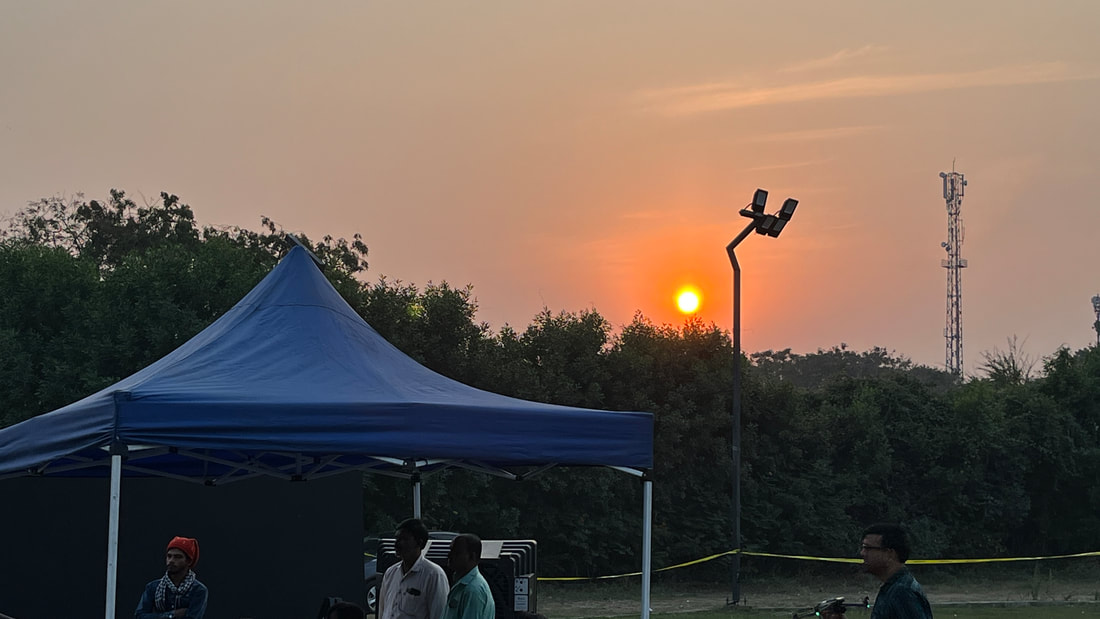|
Makar Sankranti ist ein grosses Festival hier, das vier Tage dauert. Wie so oft in Indien hat es verschiedene Namen, bzw. es gibt unterschiedliche Begriffe für die diversen Festivitäten: Bhogi, Lohri, Pongal, etc. Grundsätzlich geht es darum, das alte Jahr hinter sich zu lassen und das neue zu begrüssen, auf gute Ernte zu hoffen, die Sonne anzubeten. Es ist ein fröhliches Fest, bei dem das Zusammensein im Vordergrund steht. Folgende Rituale gehören dazu: am Vortag (13. Januar) wird ein Feuer entfacht, ähnlich wie der Zürcher Böögg 😉, in dem alte Sachen verbrannt werden, die man nicht mehr benötigt. Auch werden Samen für die gute Ernte ins Feuer geworfen. Dazu kommen Musiker (ich habe nur Männer gesehen) mit (lauten!) Schlaginstrumenten, es wird getanzt und es gibt traditionelle Speisen, v.a. süsse. An Sankranti (14. Januar) selbst gibt es wieder traditionelles Essen. Wir waren zu Mittag in einem Restaurant, wo wir einen vegetarischen Thali gegessen haben. Bei einem Thali werden immer ganz viele unterschiedliche Speisen in kleinen Schalen serviert. Traditionell isst man diese Speisen dann auf einem Bananenblatt. Am Vortag von Sankranti und an Sankranti sollte man vegetarisch essen und keinen Alkohol konsumieren. Nicht-Vegetarisches und Alkohol darf man dann an den zwei folgenden Tagen, die immer noch Festtage sind, konsumieren. Auch zum Fest gehört das Drachen-steigen-lassen. Es gibt richtige Wettbewerbe und ist natürlich sehr beliebt. Wir waren an einem grossen Festplatz in Secunderabad (das "alte" Hyderabad), wo jede und jeder Drachen steigen lassen kann; wo auch immer die Person gerade steht. Man versucht dann, die anderen Drachen zu stören, wenn man nicht nur mit seinem eigenen beschäftigt ist. Wir haben dort auch richtig gute Drachenflieger in einem abgesperrten Gebiet gesehen. Das war dann wahrscheinlich der eigentliche, offizielle Wettbewerb und recht beeindruckend. Hier haben die Drachen sich nicht gegenseitig gestört, aber sind Figuren geflogen - oder es waren besonders schöne Drachen. Auf dem Festplatz gibt es auch eine Bühne, wo Tanz oder Musik geboten wird (immer traditionell) und Hunderte Essensstände. Es ist chaotisch mit den vielen Leuten, aber irgendwie funktioniert es immer und wir haben keine Unfälle gesehen. Man muss sich Zeit nehmen, um mit der Menge in einem gemütlichen Tempo zu spazieren, dann kommt man auch zum Ziel. Nicht so schön ist der Abfall, der überall herumliegt. Auf jeden Fall hatten wir Spass, so wie die vielen anderen Leute auch. Makar Sankranti is a big festival here that lasts four days. As is so often the case in India, it has different names, or rather there are different terms for the various festivities: Bhogi, Lohri, Pongal, etc. Basically, it is about leaving the old year behind and welcoming the new one, hoping for a good harvest and worshipping the sun. It is a cheerful festival where the focus is on being together. The following rituals are part of it: the day before (13 January), a fire is lit, similar to the Zurich Böögg 😉, in which old things that are no longer needed are burned. Seeds for the good harvest are also thrown into the fire. There are also musicians with (loud!) percussion instruments, dancing and traditional dishes, especially sweet ones. On Sankranti (14 January) itself, there is traditional food again. We went to a restaurant for lunch where we ate a vegetarian thali. At a thali, lots of different dishes are served in small bowls. Traditionally, this food is eaten on a banana leaf. On the day before Sankranti and on Sankranti, you should eat vegetarian food and not consume alcohol. Non-vegetarian food and alcohol can then be consumed on the two following days, which are still festive days. Flying kites is also part of the festival. There are competitions and it is of course very popular. We were at a large fairground in Secunderabad (the ‘old’ Hyderabad), where anyone and everyone can fly kites, wherever they happen to be standing. You then try to disturb the other kites if you are not only busy with your own. We also saw some really good kite flyers there in a cordoned-off area. This was probably the actual, official competition and quite impressive. Here the kites didn't interfere with each other, but flew figures - or they were particularly beautiful kites. There is also a stage on the fairground where there is dancing or music (always traditional) and hundreds of food stalls. It is chaotic with so many people, but somehow it always works and we didn't see any accidents. You have to take your time to walk with the crowd at a leisurely pace, then you will get to your destination. What's not so nice is the rubbish lying around everywhere. In any case, we had fun, as did the many other people. Links: das Essen beim Bhogi (Feuer) - Mitte: wir haben traditionelle Speisen von einer Nachbarin bekommen - Rechts: unser Thali Makar Sankranti est un grand festival ici qui dure quatre jours. Comme souvent en Inde, il a différents noms, ou plutôt il existe différents termes pour les diverses festivités : Bhogi, Lohri, Pongal, etc. En principe, il s'agit de laisser l'ancienne année derrière soi et d'accueillir la nouvelle, de prier pour une bonne récolte, d'invoquer le soleil. Il s'agit d'une fête joyeuse où la convivialité est au premier plan. Les rituels suivants en font partie : la veille (13 janvier), on allume un feu, un peu comme le Böögg zurichois 😉, dans lequel on brûle les vieilles choses dont on n'a plus besoin. Des graines pour les bonnes récoltes sont également jetées dans le feu. Des musiciens (je n'ai vu que des hommes) viennent avec des instruments de percussion (bruyants !), on danse et on mange des plats traditionnels, surtout sucrés. Le jour de Sankranti (14 janvier), il y a à nouveau des repas traditionnels. Nous avons déjeuné dans un restaurant où nous avons mangé un thali végétarien. Lors d'un thali, de nombreux plats différents sont servis dans de petits bols. Traditionnellement, on mange ces plats sur une feuille de bananier. La veille de Sankranti et le jour-même, on mange végétarien et on ne consomme pas d'alcool. Les deux jours suivants, qui sont toujours des jours de fête, on peut consommer des aliments non végétariens et de l'alcool. De piloter des cerfs-volants fait également partie de la fête. Il y a de vraies compétitions et c'est bien sûr très populaire. Nous étions sur une grande place de fête à Secunderabad (l'« ancienne » Hyderabad), où tout le monde peut faire voler des cerfs-volants, où qu'ils se trouvent. On essaie alors de perturber les autres cerfs-volants quand on n'est pas uniquement occupé par le sien.
Nous y avons aussi vu de très bons cerfs-volistes dans une zone fermée. Il s'agissait probablement de la compétition officielle, assez impressionnante. Ici, les cerfs-volants ne se gênaient pas entre eux, mais faisaient des figures - ou alors c'étaient des cerfs-volants particulièrement beaux. Sur la place de fête, il y a aussi une scène avec de la danse ou de la musique (toujours traditionnelle) et des centaines de stands de nourriture. C'est chaotique avec toutes ces personnes, mais d'une manière ou d'une autre, ça fonctionne toujours et nous n'avons pas vu d'accidents. Il faut prendre le temps de se promener avec la foule à un rythme tranquille, et on arrive à destination. Ce qui n'est pas très chouette sont les déchets qui traînent partout. En tout cas, nous nous sommes bien amusés, comme beaucoup d'autres personnes.
0 Comments
Unsere 3-Tages-Reise war schon lange als Geburtstagsgeschenk für Yashi geplant. So reisen wir also wieder ab, kaum sind wir aus Goa zurückgekehrt. Dieses Mal ist es ein kultureller Aufenthalt. Wir sehen die umwerfend schönen und beeindruckenden Monumente in Agra: das Mausoleum von Akbar in Sikandra, den "Baby Taj" = Tomb of Itimad-ud-Daulah, die Festung von Agra und natürlich den Taj Mahal. Auch zwei Gärten sind auf unserem Programm. Die Mughals haben ihre Kunst aus Persien nach Indien gebracht (übrigens natürlich auch nach Hyderabad) und die Herrschenden waren super reich; so entstanden diese fantastischen Mausoleen, die stark von der muslimischen Kultur geprägt sind. Wir verbringen zwei Tage mit einem super guten Guide, den wir sehr empfehlen. Er heisst Nadeem und erklärt uns die Geschichte so, dass wir sie verstehen und uns sogar an vieles erinnern. Was wir unterschätzt haben, ist die Kälte. Wir haben grad mal genug Kleider, um den Tag durch nicht zu frieren, aber wohnen in einem Homestay, das nicht geheizt ist. Bei 6-8 Grad in der Nacht und Steinboden, ist es dann doch recht kalt. Abgesehen davon, können wir auch dieses Homestay sehr empfehlen: es wird von einer super freundlichen Familie geführt. Wir stehen v.a. im Kontakt mit den "Kindern", die sich um die Gäste kümmern und noch recht jung sind. Man ist in 15 Gehminuten beim Taj und doch ist die Strasse sehr ruhig. Ausserdem macht es Spass, die anderen Gäste beim Frühstück oder Abendessen kennenzulernen. Wir sind sehr motiviert, mehr in Indien zu reisen. Dieses (riesige) Land hat extrem viel zu bieten. Agra Fort, tomb of Itimad-ud-Daulah, tomb of Akbar Our 3-day trip had been planned for a long time as a birthday present for Yashi. So we are leaving again, barely having returned from Goa. This time it is a cultural stay. We see the stunningly beautiful and impressive monuments in Agra: the mausoleum of Akbar in Sikandra, the ‘Baby Taj’ = Tomb of Itimad-ud-Daulah, the fortress of Agra and of course the Taj Mahal. Two gardens are also on our programme. The Mughals brought their art from Persia to India (and of course also to Hyderabad) and the rulers were super rich; this is how these fantastic mausoleums, which are strongly influenced by Muslim culture, came about. We spend two days with a super good guide, whom we highly recommend. His name is Nadeem and he explains history to us in such a way that we understand it and even remember a lot of it. What we underestimated was the cold. We only have enough clothes to not freeze during the day, but we live in a homestay that is not heated. With temperatures between 6-8 degrees at night and stone floors, it is quite cold. Apart from that, we can highly recommend this homestay: it is run by a super friendly family. We are mainly in contact with the "children", who take care of the guests and are still quite young. It takes only 15 minutes to walk to the Taj, yet the street is very quiet. It's also fun to meet the other guests at breakfast or dinner. We are very motivated to travel more in India. This (huge) country has so much to offer. It's all inlaid, nothing is painted Notre voyage de trois jours était prévu depuis longtemps comme cadeau d'anniversaire pour Yashi. Nous repartons donc à peine rentrés de Goa. Cette fois, c'est un séjour culturel. Nous voyons les monuments d'Agra, d'une beauté époustouflante et impressionnante : le mausolée d'Akbar à Sikandra, le « Baby Taj » = Tomb d'Itimad-ud-Daulah, la forteresse d'Agra et bien sûr le Taj Mahal. Deux jardins font également partie de notre programme. Les Moghols ont apporté leur art de Perse en Inde (d'ailleurs bien sûr aussi à Hyderabad) et les maharadjas étaient super riches ; c'est ainsi que sont nés ces fantastiques mausolées, fortement marqués par la culture musulmane. Nous passons deux jours avec un excellent guide que nous recommandons vivement. Il s'appelle Nadeem et nous explique l'histoire de manière à ce que nous la comprenions et que nous nous souvenions même de beaucoup de choses. Ce que nous avons sous-estimé, c'est le froid. Nous avons juste assez de vêtements pour ne pas avoir froid toute la journée, mais nous vivons dans un homestay qui n'est pas chauffé. Avec 6-8 degrés la nuit et un sol en pierre, il fait tout de même assez froid. Cela mis à part, nous recommandons vivement ce homestay : il est géré par une famille super sympathique. Nous sommes surtout en contact avec les "enfants" qui s'occupent des hôtes et qui sont encore très jeunes. On est à 15 minutes à pied du Taj, mais la rue est très calme. De plus, c'est amusant de rencontrer les autres hôtes au petit-déjeuner ou au dîner. Nous sommes très motivés pour voyager davantage en Inde. Ce pays (immense) a énormément à offrir. Garden on the opposite riverside of Taj Mahal, our homestay and Nadeem, the guide.
Meine erste Reise in Indien ausserhalb von Hyderabad führt uns nach Goa, an einen wunderschönen, ruhigen Strand, wo wir unsere Freunde wieder treffen. Wir verbringen hier 6 Tage Ferien, inklusive dem Neujahrsabend. Übrigens: alles Gute fürs neue Jahr! Meine erste Lehre: wir fliegen nur eine Stunde von Hyderabad bis Goa, aber wir sind effektiv den ganzen Tag unterwegs. Die Abfahrt von zuhause startet drei Stunden vor dem Flug, der etwas Verspätung hat. Nach der Ankunft warten wir (nicht sehr lange) aufs Gepäck und fahren wieder fast zwei Stunden zum Strand. Die Reise beginnt also um 09:45 und endet so gegen 17 Uhr. Zuerst ist Erholung angesagt. Die Temperaturen sind sommerlich (für uns, es ist ja Winter hier), tagsüber in der Sonne echt heiss, morgens und abends sehr angenehm. Das Wasser hat die ideale Wärme 😁. Nach ein paar Tagen machen wir eine früh-morgendliche Bootsfahrt auf dem Fluss ("Backwaters") und sehen viele Vögel. Es ist so schön still, auch weil der Bootsführer mit einer Stange stakt. An einem anderen Tag besuchen wir in einem Tagesausflug eine Gewürzplantage. Wir beginnen mit einer Mini-Wanderung zu einem Wasserfall durch einen üppigen Dschungel und können dort unsere Füsse baden. Letztere werden von kleinen Fischen angeknabbert; d.h. die Fischchen knabbern die Hornhaut weg. Das kitzelt zuerst ein wenig, ist aber nach einer Gewöhnungsphase ganz angenehm. Nach einem guten Mittagessen mit hauseigenen Produkten, zeigt uns eine junge Frau einen Teil der Plantage und erklärt, wie die (exotischen) Gewürze wachsen. Wir sehen Pfeffer, Muskat, Betelnüsse, Kurkuma und Vanille. Super cool! Den Neujahrsabend verbringen wir in einem Restaurant am Strand. Es ist ein lustiger Abend mit (eigentlich) gutem Essen, Live-Musik (ein guter Sänger mit Gitarre und tanzen. Schön finde ich, dass dem Strand entlang in regelmässigen Abständen Feuer brennen und dann, um Mitternacht, in einer ganz dunklen Neumondnacht, viele Feuerwerke am Strand gezündet werden. Das ist schon eine einmalige Stimmung! Leider beginnt unser Neujahr mit einer bösen Magenverstimmung, die uns auf dem Heimweg bis nach Hause begleitet. Wir sind dabei, uns zu erholen. A propos Reisen in Indien: Wir verfolgen die Reise von einem befreundeten Paar, das übrigens auch kurz hier in Hyderabad war. Die Beiden erleben extrem viel in Südindien, was wir sehr inspirierend finden. Danke fürs Teilen der Eindrücke! My first trip outside of Hyderabad takes me to Goa, to a beautiful, quiet beach where we meet up with our friends again. We spend 6 days' holiday here, including New Year's Eve. By the way: Happy New Year! My first lesson: we only fly one hour from Hyderabad to Goa, but we are effectively on the road the whole day. The departure from home starts three hours before the flight, which is a bit late. After arrival, we wait (not very long) for the luggage and drive again almost two hours to the beach. So the trip starts at 9:45 and ends around 5 pm. First of all, we need to recover. The temperatures are summery (for us, it's winter here), really hot in the sun during the day, very pleasant in the morning and evening. The water is at the ideal temperature 😁. After a few days, we take an early morning boat ride on the river (‘backwaters’) and see many birds. It is so beautifully quiet, also because the boatman is poling. On another day, we visit a spice plantation on a day trip. We start with a mini-hike to a waterfall through lush jungle and can bathe our feet there. The latter are nibbled on by small fish; i.e. the fish nibble away the calluses. This tickles a little at first, but is quite pleasant after a period of getting used to it. After a good lunch with home-grown products, a young woman shows us part of the plantation and explains how the (exotic) spices grow. We see pepper, nutmeg, betel nuts, turmeric and vanilla. Super cool! We spend New Year's Eve in a restaurant on the beach. It is a fun evening with (actually) good food, live music (a good singer with a guitar), dancing and a lot of fireworks. I love the fact that there are bonfires along the beach at regular intervals and then, at midnight, in a very dark new moon night, many fireworks are ignited on the beach. It's a unique atmosphere! Unfortunately, our New Year began with a nasty stomach upset that stayed with us all the way home. We are in the process of recovering. A propos travelling in India: We are following the journey of a couple who are friends of ours and who, by the way, were also here in Hyderabad for a short time. The two of them are experiencing an incredible amount in South India, which we find very inspiring. Thanks for sharing your impressions! Mon premier voyage en Inde en dehors d'Hyderabad nous conduit à Goa, sur une plage magnifique et calme, où nous retrouvons nos amis. Nous y passons six jours de vacances, y compris la soirée du Nouvel An. Au fait : tous nos vœux pour la nouvelle année ! Mon premier enseignement : nous ne prenons qu'une heure de vol entre Hyderabad et Goa, mais nous sommes effectivement en route toute la journée. Le départ de la maison commence trois heures avant le vol, qui a un peu de retard. À l'arrivée, nous attendons (pas très longtemps) les bagages et reprenons la route pour la plage pendant près de deux heures. Le voyage commence donc à 9h45 et se termine vers 17h. Tout d'abord, le repos est de rigueur. Les températures sont estivales (pour nous, c'est l'hiver ici), vraiment chaudes pendant la journée au soleil, très agréables le matin et le soir. L'eau a une chaleur idéale 😁. Après quelques jours, nous faisons une promenade en bateau tôt le matin sur la rivière (« backwaters ») et voyons beaucoup d'oiseaux. C'est tellement beau et silencieux, notamment parce que le conducteur du bateau fait de la perche. Un autre jour, nous visitons une plantation d'épices dans le cadre d'une excursion d'une journée. Nous commençons par une mini-randonnée vers une cascade à travers une jungle luxuriante où nous pouvons baigner nos pieds. Ces derniers sont grignotés par de petits poissons ; c'est-à-dire que les petits poissons grignotent la cornée. Cela nous chatouille un peu au début, mais après une phase d'adaptation, c'est très agréable. Après un bon déjeuner avec des produits maison, une jeune femme nous montre une partie de la plantation et nous explique comment poussent les épices (exotiques). Nous voyons du poivre, de la muscade, des noix de bétel, du curcuma et de la vanille. Super cool ! Nous passons la soirée du Nouvel An dans un restaurant sur la plage. C'est une soirée amusante avec (en fait) de la bonne nourriture, de la musique live (un bon chanteur avec une guitare) et de la danse. Ce que je trouve beau, c'est que des feux sont allumés à intervalles réguliers le long de la plage et qu'ensuite, à minuit, par une nuit de nouvelle lune très sombre, de nombreux feux d'artifice sont tirés sur la plage. C'est une ambiance unique ! Malheureusement, notre nouvel an commence par une vilaine indigestion qui nous accompagne jusqu'à la maison. Nous sommes en train de nous remettre. À propos de voyages en Inde : nous suivons le voyage d'un couple d'amis, qui a d'ailleurs brièvement séjourné ici, à Hyderabad. Le couple vit énormément de choses dans le sud de l'Inde, ce que nous trouvons très inspirant. Merci de partager leurs impressions !
Die ersten zwei Monate im Büro sind fast vorbei und neben dem Tagesgeschäft habe ich einige spannende Dinge erlebt. Zum einen gab es in dieser Zeit einige Besuche von Kolleginnen und Kollegen aus Zürich, aus unserem Bereich, von unseren internen Kunden und aus anderen Bereichen. Da das Jahresende vor der Tür stand, gab es die Möglichkeit, dies mit den Teams bei einem gemeinsamen Abendessen zu feiern. Für drei Tage war ich in Bangalore, um an der Abschlussveranstaltung des diesjährigen Leadership Training Program teilzunehmen. Es war schön, auch dort viele Kolleginnen und Kollegen zu treffen, sowohl im Büro als auch beim Abendessen. In der gleichen Woche, zurück in Hyderabad, fand zum zweiten Mal das Swiss Re Futurize Event, diese Jahr im Le Meridien Hotel, statt. Bangalore war virtuell zugeschaltet und steuerte auch Präsentationen bei. Swiss Re engagiert sich weltweit für gemeinnützige Institutionen. In Hyderabad ist es die Akshaya Patra Foundation, die seit 20 Jahren für das Mid-Day Meal Programme (MDM) verantwortlich ist, das täglich ein warmes, nahrhaftes Mittagessen für Schüler staatlicher Schulen in Indien bereitstellt. Das Hauptziel der Stiftung ist die Bekämpfung von Unterernährung und die Unterstützung des Rechts auf Bildung für sozioökonomisch benachteiligte Kinder. Das Mittagessen oder Frühstück, das in den Schulen serviert wird, ist ein Anreiz für die Kinder, zur Schule zu gehen, und für die Eltern, ihre Kinder zur Schule zu schicken. Wir waren 15 Personen und haben zuerst in kleinen Gruppen mit den Schülern in der Klasse interagiert. Ich war erstaunt, wie aufgeweckt und interessiert alle waren. In der Mittagspause haben wir dann das Essen geschöpft. In der darauffolgenden Woche waren Isa und ich beim Indo-French Chamber of Commerce and Industry Dinner im Novotel HICC. Auch diese Veranstaltung war sehr aufregend, unter anderem weil wir beide in unserer indischen Kleidung auffielen. Am nächsten Tag, Freitag den 13., fand die Jahresabschlussfeier des gesamten Hyderabad Office statt. Ausnahmsweise nachmittags, draußen, mit Spielen und dann viel Tanzen. Jetzt ist etwas Ruhe eingekehrt, die meisten Kolleginnen und Kollegen in Europa haben über Weihnachten und Neujahr zwei Wochen frei. Doch ein Brand auf dem Bürogelände, im Nachbargebäude unseres Büros, sorgte am Samstag für Aufregung. Denn es gab eine Explosion, die auch bei uns Fenster und Bildschirme zerstört hat. Deshalb bleibt das Büro in den nächsten Wochen geschlossen und wir machen alle Homeoffice oder fahren in den Urlaub 😅. My first two months in the office are almost over and I have experienced some exciting things in addition to the day-to-day business. Firstly, there have been a few visits from colleagues from Zurich, from our division, from our internal customers and from other divisions. As the end of the year was just around the corner, there was the opportunity to celebrate this with the teams at a joint dinner. I was in Bangalore for three days to take part in the closing event of this year's Leadership Training Programme. It was great to meet many colleagues there too, both in the office and over dinner. In the same week, back in Hyderabad, the Swiss Re Futurize event took place for the second time, this year at Le Meridien Hotel. Bangalore was connected virtually and also contributed presentations. Swiss Re is committed to supporting charitable institutions worldwide. In Hyderabad, it is the Akshaya Patra Foundation, which has been responsible for the Mid-Day Meal Programme (MDM) for 20 years, providing a hot, nutritious lunch to students of government schools in India every day. The foundation's main objective is to combat malnutrition and support the right to education for socio-economically disadvantaged children. The lunch or breakfast served in the schools is an incentive for the children to go to school and for the parents to send their children to school. There were 15 of us and we first interacted with the students in class in small groups. I was amazed at how bright and interested everyone was. We then scooped the food during the lunch break. The following week, Isa and I attended the Indo-French Chamber of Commerce and Industry Dinner at the Novotel HICC. This event was also very exciting, partly because we both stood out in our Indian clothes. The next day, Friday the 13th, was the end-of-year party for the entire Hyderabad office. Exceptionally in the afternoon, outside, with games and then lots of dancing. Things have calmed down a bit now, as most colleagues in Europe have two weeks off over Christmas and New Year. However, a fire on the office premises, in the building next door to our office, caused a stir on Saturday. There was an explosion that also destroyed our windows and screens. That's why the office will be closed for the next few weeks and we'll all be working from home or going on holiday 😇. Les deux premiers mois au bureau sont presque terminés et, en plus des affaires courantes, j'ai vécu des choses passionnantes. Tout d'abord, cette période a été marquée par quelques visites de collègues de Zurich, de notre secteur, de nos clients internes et d'autres secteurs. Comme la fin de l'année approchait, nous avons eu l'occasion de la fêter avec les équipes lors d'un dîner commun.
J'ai passé trois jours à Bangalore pour assister à la cérémonie de clôture du Leadership Training Program de cette année. Ce fut un plaisir de rencontrer là aussi de nombreux collègues, tant au bureau qu'au dîner. La même semaine, de retour à Hyderabad, le Swiss Re Futurize Event s'est tenu pour la deuxième fois à l'hôtel Le Méridien. Bangalore était connectée virtuellement et a également contribué à des présentations. Swiss Re s'engage dans le monde entier pour des institutions d'utilité publique. A Hyderabad, c'est la fondation Akshaya Patra qui est responsable depuis 20 ans du Mid-Day Meal Programme (MDM), qui fournit chaque jour un repas chaud et nutritif aux élèves des écoles publiques en Inde. L'objectif principal de la fondation est de lutter contre la malnutrition et de soutenir le droit à l'éducation des enfants défavorisés sur le plan socio-économique. Le déjeuner ou le petit déjeuner servi dans les écoles est une incitation pour les enfants à aller à l'école et pour les parents à envoyer leurs enfants à l'école. Nous étions 15 et avons d'abord interagi en petits groupes avec les élèves en classe. J'ai été étonnée de voir à quel point tout le monde était éveillé et intéressé. Pendant la pause de midi, nous avons ensuite puisé la nourriture. La semaine suivante, Isa et moi avons assisté au dîner de la Chambre de commerce et d'industrie franco-indienne au Novotel HICC. Cet événement était également très excitant, notamment parce que nous nous sommes tous les deux fait remarquer dans notre tenue indienne. Le lendemain, vendredi 13, a eu lieu la fête de fin d'année de tout le bureau d'Hyderabad. Exceptionnellement l'après-midi, à l'extérieur, avec des jeux et ensuite beaucoup de danse. Maintenant, un peu de calme est revenu, la plupart des collègues en Europe ont deux semaines de congé pour Noël et le Nouvel An. Mais un incendie sur le site des bureaux, dans le bâtiment voisin de notre bureau, a provoqué l'émoi samedi. En effet, une explosion s'est produite et a également détruit des fenêtres et des écrans chez nous. C'est pourquoi le bureau restera fermé pendant les prochaines semaines et nous ferons tous du home office ou partirons en vacances 😎. |
About usWe are a couple in the mid-fifties and are going to live for two years in Hyderabad, India. Time in Hyderabad
Archives
May 2025
Categories |
